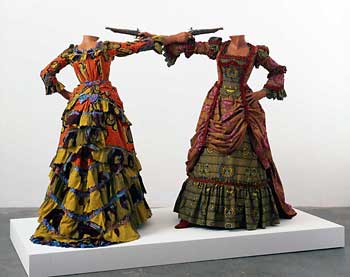The above video is excerpted from the Season 5 episode Transformation, premiering on Wednesday, October 21, 2009 at 10pm (ET) on PBS (check local listings). Whether satirizing society or reinventing icons of literature, art history, and popular culture, the artists in Transformation—Paul McCarthy, Cindy Sherman, and Yinka Shonibare MBE—inhabit the characters they create and capture the sensibilities of our age.
Who is Yinka Shonibare MBE and what does he have to say about transformation?
Yinka Shonibare MBE was born in 1962 in London, England, but grew up in Lagos, Nigeria; he lives and works in London. Known for using batik in costumed dioramas that explore race and colonialism, Yinka Shonibare MBE also employs painting, sculpture, photography, and film in work that disrupts and challenges our notions of cultural identity. Taking on the honorific MBE as part of his name in everyday use, Shonibare plays with the ambiguities and contradictions of his attitude toward the Establishment and its legacies of colonialism and class. In multimedia projects that reveal his passion for art history, literature, and philosophy, Shonibare provides a critical tour of Western civilization and its achievements and failures. At the same time, his sensitive use of his own foibles (vanity, for one) and challenges (physical disability) provide an autobiographical perspective through which to navigate the contradictory emotions and paradoxes of his examination of individual and political power.
On the subject of transformation in art, Shonibare discusses the mutable nature of his materials (in the forthcoming Season 5 book):
I started to look at the representation of the ideas of African art and at what things represented Africa. I came upon the fabrics. Although they are associated with Africa, they have their origins in Indonesia. The Dutch started to produce these fabrics industrially for the Indonesian markets towards the end of the nineteenth century but the industrially produced versions were not popular there, so they tried West Africa. There the fabrics were really popular and they were appropriated. And now they are associated with Africa. I like the fact that the fabrics have a multi-layered history. So I guess the point I’m trying to make is that things are not always what they seem. I enjoy working with that.
What happens in Shonibare’s segment in Transformation this October?
“My work, all along, has been a critique of Empire,” says Yinka Shonibare MBE, adopting the honorific title of Member of the Order of the British Empire, with willful irony, as part of his name. “I like the idea of parodying or mimicking the notion of class.”
Shown in his London studio, Shonibare is working on his first series of drawings in twelve years, taking as his subject: climate change—political, economic, environmental—and dedicating a work to “the architects of the present economic disaster” including Henry Paulson, Ben Bernanke, and Milton Friedman. The artist is on hand for the installation of a retrospective of sculptures—headless, “post-racial,” mannequins dressed in vibrant costumes—at the MCA Sydney. “The fabrics are multi-layered—things are not always what they seem,” he says about his use of industrially produced, Dutch wax print cloth, which has a complex colonial history stretching from Indonesia to the artist’s native Nigeria.
“I’ve always enjoyed using beauty and seduction as a way of engaging people with the work,” he says, pointing out the underlying dark themes in works such as Scramble for Africa (2003) and Black Gold II (2006). Acting as the protagonist in two photographic series, in Diary of a Victorian Dandy (1998) Shonibare re-imagines a series of paintings by William Hogarth while in the Oscar Wilde inspired Dorian Gray (2001) he explores personal themes of mortality, vanity and physical disability. The final work in the segment, the film Un Ballo in Maschera (2004), is a masked ballet that recounts the assassination of King Gustav III of Sweden. “Power creates excess,” he asserts, while playfully admitting, “I also, actually, would like to have the trappings of wealth myself, even though I may be criticizing it.”

Yinka Shonibare MBE. "How to Blow up Two Heads at Once (Ladies)," 2006. Two-life size mannequins, two guns, Dutch wax printed cotton, shoes, and leather riding boots, Plinth overall 63 x 96 1/2 x 48 inches, each figure 63 x 61 x 48 inches. Collection of Davis Museum and Cultural Center, Wellesley College, Wellesley, MA. Photo by Stephen White, © Yinka Shonibare MBE, courtesy the artist, James Cohan Gallery, New York and Stephen Friedman Gallery, London.
What else has Shonibare done?
Shonibare studied at Byam Shaw School of Art, London (1984-89) and earned an MA from Goldsmiths College, London University (1991). Among his awards are the MBE (Member of the Order of the British Empire) (2005); a fellowship at Goldsmith’s College (2003); and the Art for Architecture Award, Royal Society of Arts (1998). Shonibare was nominated for the Turner Prize (2004). His work has appeared in major exhibitions at the Santa Barbara Museum of Art, California (2009); Cooper-Hewitt National Design Museum, New York, (2005); Fabric Workshop and Museum, Philadelphia (2004); and Museum Boijmans Van Beuningen, Rotterdam (2004), among others. He has participated in international events including Documenta (2003); Spoleto Festival, Charleston (2003); and the Venice Biennale (2001).
Where can I see more of Shonibare’s work between now and the Art21 premiere this October?
YInka Shonibare MBE is represented by James Cohan Gallery in New York and Stephen Friedman Gallery in London. His mid-career retrospective is on view at the Brooklyn Museum of Art until September 20th, after which it travels to the National Museum of African Art at the Smithsonian, in Washington, D.C. from November 11, 2009—March 7, 2010. His site-specific commission Party Time: Re-Imagine is on view at the Newark Museum of Art until January 3rd, 2010.
What’s your take on Shonibare’s inclusion in Season 5?
Tell us what you think by leaving a comment below!




Pingback: Season 5 Sneak Peek: Yinka Shonibare - BOMBLog
Pingback: What’s Cookin at the Art21 Blog: A Weekly Index | Art21 Blog